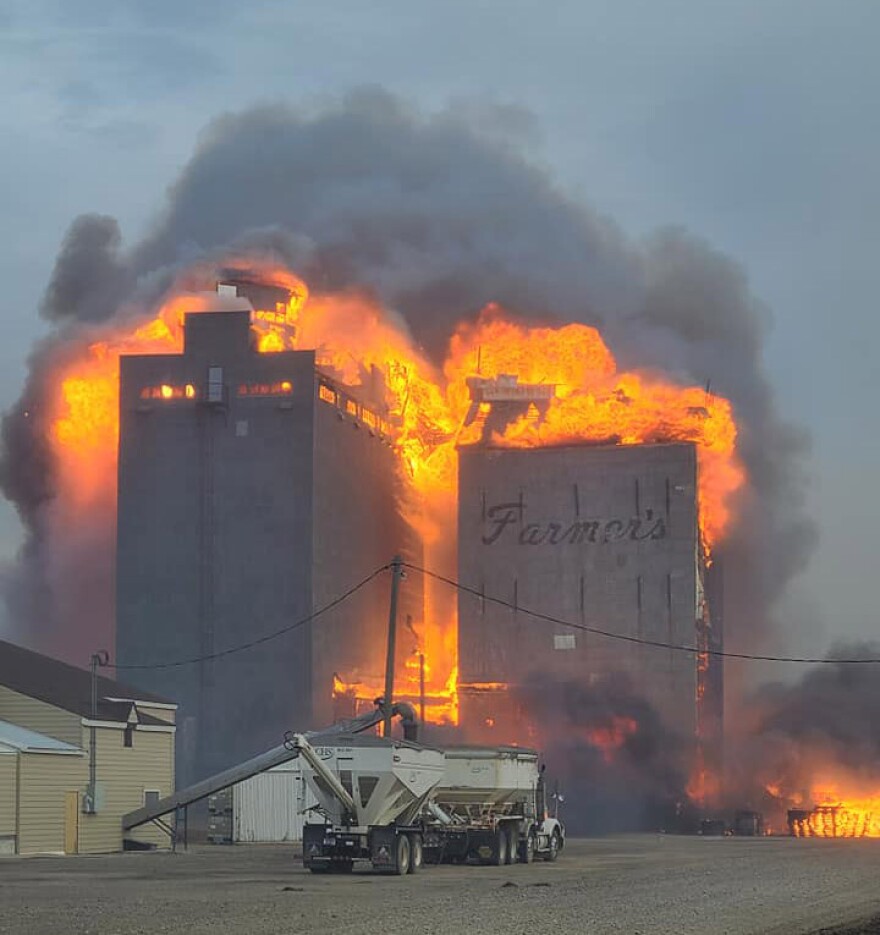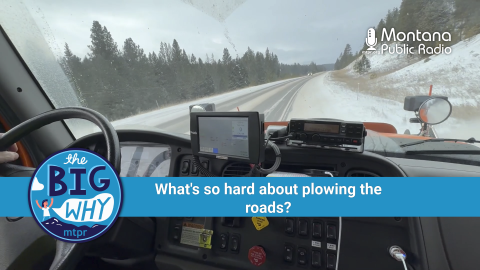Austin Amestoy: Welcome to the Big Why, a series from Montana Public Radio where we find out what we can discover together. I'm your host, Austin Amestoy. This is a show about listener powered reporting. We'll answer questions large or small about anything under the Big Sky. By Montanans for Montana, this is the Big Why.
Today we were talking about the small central Montana town of Denton, population about 200. And to do that, I'm here with reporter Aaron Bolton. Hey Aaron.
Aaron Bolton: Hey Austin.
Austin Amestoy: So, Aaron, tell us why we're diving into Denton today.
Aaron Bolton: Well, a wildfire burned through the town back in December of 2021. It burnt over 10,000 acres and destroyed 25 homes. And the listener wanted to know, how is the town of Denton rebuilding?
- A rare winter wildfire is a sign of climate change lengthening fire season
- Northwestern Energy: Downed power line may have sparked the West Wind Fire
- December wildfires leave destruction and trauma in their wake
- Wildfire destroys 24 houses in central Montana town
- Montana wildfire update for December 01, 2021
Austin Amestoy: Wow, I definitely remember that. So, where do we start the conversation?
Aaron Bolton: Well, I figured the best place to start was Denton itself. So I went there. Denton is your typical small agricultural town. It's only 11 blocks long, with mostly older homes lining the streets. And one cafe in the middle of town. Driving around, there's not many signs of the West Wind fire. Though it did see one house with a bit of charred siding. But I did meet Josh Poser, who lost his home in the fire, and his new place is still under construction.
Josh Poser: Sorry, a little bit of a mess.
Aaron Bolton: His family's been living in a camper for over a year while they build.
Josh Poser: And we have a little heated room in the shop that it's a little bit of an extension. We don't need it quite as much now that it's getting warmer.
Aaron Bolton: Poser says it's been rough with two little girls and their black lab all crammed into the camper at night. He says many people who lost homes here are rebuilding outside of town, but he's committed to staying right here.
Austin Amestoy: Wow. That is some impressive dedication. If others were moving out of town, why did Poser decide to rebuild in the same place?
Aaron Bolton: Denton is his hometown, and he moved back here with his wife, Robyn, to raise their family. When I visited, Robyn and the girls were playing on the swing set in their yard. It's easy to see why they like it here, as it's a quiet, safe place to raise young kids. Their new house is framed but is still unfinished on the outside and inside. He hopes to start living in it this fall. Poser, who's a homebuilder by trade, says he's constructing his new house in a more fire resilient way.
Josh Poser: There will be concrete siding. Hardie siding is what we're going to use, which is obviously fire resistant. Metal flashing around the bottom, metal soffit and fascia, metal roof. Just things on the outside that are definitely going to slow it down compared to before. We had, everything was wood, wood windows, wood siding, wood everything. So it was a recipe for disaster.
Aaron Bolton: Poser also removed a lot of bushes on his property and he's laying gravel around his new homes foundation to make sure nothing flammable will burn close to the house. All good tactics for fire resiliency, according to experts.
Austin Amestoy: Okay, so Poser is working to make those changes as he rebuilds. But did you get a sense while you were in Denton that others in the area are using fire resistant construction methods, too?
Aaron Bolton: Poser says he hasn't heard much talk about it.
Josh Poser: Yeah, I don't know that there's been a lot of talk about anything besides, like just fighting the fire.
Aaron Bolton: But officials are trying to change that. The Montana Department of Natural Resources and Conservation hired Anika Peila to help homeowners in central and eastern Montana assess their home's wildfire risk and what they can change to lower the potential for it to burn down. Peila says that work hasn't made its way to Denton yet.
Anika Peila: My goal is to come back to Denton and walk with homeowners to do that eventually. So, we're getting there. It's just a slow and steady process. Yeah.
Austin Amestoy: So there's at least some appetite to help homeowners and communities build in a fire resistant way. But this conversation has me wondering, why was the West Wind Fire, that burned Denton, so destructive in the first place? I mean, my gut tells me that a winter fire shouldn't be so severe.
Aaron Bolton: There wasn't any snow cover on the ground at the time, and all the dead vegetation had dried up because the high temperature that day was about 66 degrees. That's about 30 degrees above average for that time of year. Here's Don Pyrah with the DNRC, who managed the response to that fire.
Don Pyrah: But the one thing that is probably the biggest overriding factors, the wind was blowing 70 miles an hour and it was 56 degrees in the middle of the night. That doesn't happen. And that combination of things essentially made it no different than if it was today. So, that's not normal.
Aaron Bolton: Strong winds like that during December are actually really normal, but those high temps aren't. University of Montana climate researcher Phil Higuera says climate change is essentially forcing communities and grasslands to roll the dice more often. When fire prone conditions collide with typical weather patterns, like strong winter winds, climate change is essentially loading the dice in favor of extreme fires. This collision of extreme fire risk and strong winds also happened in Boulder, Colorado, just weeks after the Denton fire. The Marshall Fire was among the most destructive in state history. Higuera says all the factors in extreme fire events across grassland ecosystems point one way.
Phil Higuera: It's clearly moving in the direction of more home and structure loss from fire.
Austin Amestoy: So, fire risk is up in grasslands. But do we have a sense of how much more often fires are happening in those landscapes?
Aaron Bolton: We do. For a long time, many academics and the public were very focused on extreme wildfires in forested ecosystems. But a 2017 University of Nebraska study found the total area burned by wildfires on the Great Plains increased by 400% from 1985 to 2014.
Austin Amestoy: Whoa. That is a huge jump. What's driving that trend?
Aaron Bolton: University of Florida researcher Victoria Donovan, who led that 2017 study, says the overarching reason is climate change. We are seeing an increasing number of days with hot and dry conditions across the Great Plains. But she also notes that we've been suppressing fire and grasslands like we have in forests for over 100 years. That's given woody vegetation like shrubs and trees, such as the western red cedar, a chance to expand the range.
Victoria Donovan: It generally existed in kind of ravines or gully areas where fire wasn't penetrating and so it was largely controlled by frequent fires moving through grasslands. So, as we have suppressed fire over the last century or more in these areas, we're seeing that it's able to rapidly expand out into grasslands.
Aaron Bolton: That extra woody vegetation on the landscape produces more extreme wildfires and also fires that are capable of sending hot embers in the air that can start other fires and ignite homes. Making wildfires harder to control.
Austin Amestoy: Wow, that definitely sounds like a future we want to avoid. Is there anything we can do now to prevent those more destructive fires?
Aaron Bolton: Researchers and fire managers agree that prescribed fire needs to be returned to the landscape to control the amount of vegetative fuel that's cropped up because fire was essentially removed from the ecosystem. But there will still be more hot, dry days, and that means people in communities need to start thinking about how they can become more resilient when wildfires do happen. Individuals can build more resiliently or retrofit their homes like Poser's doing it in Denton. But many experts say states and localities need to adopt codes in zoning that mandate that kind of construction in fire prone areas, and also provide funding to help people get that work done.
Austin Amestoy: Well, Aaron thanks for checking in on Denton for us.
Aaron Bolton: No problem, Austin.
Austin Amestoy: Now we want to know what makes you curious about Montana. Submit your questions below. Find us wherever you listen to podcasts and help others find the show by sharing it and leaving a review.
-
When it comes to winter driving, everyone wants their route clear and dry, and they want it done quickly. Why don't the plows come sooner or more often? Why don't they drop more salt or deicer? Why not get more drivers on the road? Tag along as a Montana snowplow driver prepares for a big winter storm and find out more about the logistical, environmental and technical challenges that come with keeping the roads clear of snow.
-
How do cabbage and spices become ingredients for community building? In Korea, the answer is kimjang, the fall tradition of making and sharing kimchi. This week on The Big Why, we visit a farm in the Bitterroot Valley where a group of Montanans came together to keep a food custom alive and find comfort and connection among the cabbage.
-
In Montana, abortion access has been at times illegal, legal, and stuck in limbo. Providers have weathered bombings and arson, advocates and opponents have battled it out in court, and citizens have passed a constitutional amendment affirming a woman's right to choose. One listener wants to know more about the history of reproductive rights in Montana. MTPR's Aaron Bolton reports on the underground networks, political violence and landmark court cases that got us to where we are today.
-
A flag's primary purpose is to be recognized from a distance. That means few colors, no lettering and a clear distinction from other flags. Ideally, it should be simple enough for a child to draw it from memory. So, how did Montana end up with such a complicated flag? Learn more in this episode of The Big Why.










